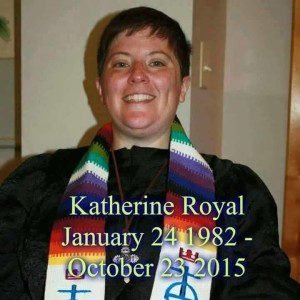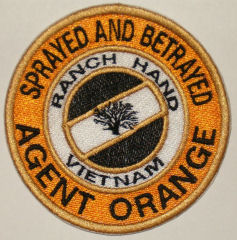Memorial Minute for Katharine “Kat” Royal:
January 28, 1982 – October 23, 2015
[Read at her memorial service in Chapel Hill, North Carolina, October31, 2015.]
I
I’m a Quaker, and at our memorial meetings, Quakers have a custom of preparing and reading what’s called a Memorial Minute. These sound in one way like biographical sketches, and so they are.
But there is a deeper dimension to them for us than simple chronology or the succession of dates and facts. That’s because of an advice that has come down to us from our founders; that advice is to “let your life preach.”

For us, the witness and message that can be discerned from our living speaks more truly and profoundly than words alone. I believe this is particularly true of Kat, and I’m grateful to her husband Micah for letting me adapt this custom for this memorial service. So these words today are about a life, and that life is the real message.
When Kat Royal was born on January 24, 1982, it was Super Bowl weekend. The story is told that her father, Scott Clark, wanted to name her Joe Montana, after the star quarterback for the San Francisco 49ers football team. But her mother’s preference for Katharine Leigh Clark prevailed.
Kat aced the tests for newborns that measured alertness and energy. But she also had spina bifida, and within days had surgery to relieve pressure on her brain. She soon learned to walk, but used leg braces and crutches.
Her father is a Vietnam War veteran, who says he “sucked up” large amounts of the highly toxic defoliant called Agent Orange while serving there in 1968. U.S. forces sprayed many millions of gallons of Agent Orange across wide swaths of that war-torn country. This chemical’s legacy can still be seen there, in birth defects and other illnesses now afflicting many in the third generation to follow that war.
The legacy could also be seen in Kat’s condition; or at least, that’s what the Veterans Administration determined. It classified her, along with several hundred other children of Vietnam vets, as “veterans” affected by wartime injuries, and included them in VA health care.

Yet whatever her physical challenges, by the age of three, Kat was so articulate that, when asked to describe her best friend at pre-school, Kat named a child and said that while she liked her, the girl complained a lot about aches and pains: she was in Kat’s opinion, a “hypochondriac.” Her mother still remembers with astonishment Kat’s properly pronounced and contextually correct use of that term while still a toddler. She also spoke many words in Spanish as well as English in those early years, and even began to learn sign language.
Her precocious mind and appealing personality soon made her something of a star. She was chosen as a March of Dimes poster child before she was four, and served as one of the charity’s main regional ambassadors for several years.
This public role was made the more exciting, at least for her parents, by the fact that they lived near Hollywood. Thus for March of Dimes telethons and other events, Kat was brought together with glamorous celebrities from many fields. She met and hobnobbed with people like actor James Garner, baseball patriarch Tommy Lasorda of the LA Dodgers, Los Angeles mayor Tom Bradley, and Olympic athlete (and Special Olympics organizer) Rafer Johnson, among others.

Her parents recall a moment at one event when Rafer Johnson, a black man who is well over six feet tall, scooped up Kat and held her close. Kat leaned her face down, and nose to nose, said pertly, and innocently to him, “Mr Johnson, why are you so dark?”
Johnson smiled and answered, with good humor but also calm profundity, “Kat, it’s a long story.”
In elementary and Junior High school, Kat is said to have been one of those very bright but not necessarily straight-A students. And when she finished Junior High, her parents managed to enroll her in an upscale Catholic girls prep school, Flintridge Sacred Heart Academy.
Kat and her parents were not Catholics, so why the switch? Social mobility is easy enough to guess; but Kat always wondered if her outside-the-lines early teen romances, one with a boy of color — another with a girl of Asian background — may have had some influence on their decision.
In any event, at Flintridge Academy, where students wore a uniform featuring plaid skirts, Kat was again bright, but not necessarily tops in grades. She was also increasingly questioning of religious orthodoxies, in this case various Catholic doctrines and mores. But she was not entirely a rebel: Micah recalls that she had a former priest in religion classes who taught a version of Liberation Theology, emphasizing social justice over otherworldly doctrines, and Kat lapped this up.
Once in junior high, her mother remembers, she and Kat watched an episode of a favorite TV series, “Touched By An Angel.” In this episode Roma Downey, as the angel Monica, brought her offer of a miracle to a group of down-and-outers huddling in a seedy bar.
Kat turned to her mother and asked what kind of miracle she would ask for if she could. “Why, for you to be cured of spina bifida,” Christine answered immediately. “What about you, Kat?”
Her daughter did not hesitate. “No more spina bifida would be good,” she said. “But I’d ask for a cure for AIDS or cancer.”

Meantime, Kat was active in a Presbyterian church youth program, where among other projects she organized Bible study programs.
When she graduated from the academy, Kat headed about 25 miles east of Flintridge to Azusa Pacific University, an evangelical Protestant school with roots in the early Pentecostal movement. And if any of you seem to recall Azusa Pacific as the school that two years ago fired a longtime professor of philosophy and theology for coming out as transgender, you are recalling correctly.
Kat enrolled there more than a decade earlier, to, as Micah puts it, “learn to change the world, in a diverse, interdenominational, and welcoming environment.” But the “welcoming” and “diversity” at Azusa were strictly within their doctrinal parameters and behavioral regulations. By this time Kat was well aware of being attracted to both men and women, but she was not asked about these experiences in her admissions process.
However, Azusa frequently invited prominent evangelical revivalists, preachers and healers, among whom were some who claimed to be used of God to fix not only physical ills, but also such dreadful “afflictions and temptations” as same-sex attraction.
Amid frequent and fervent altar calls to come forward for prayer and healing, Kat was brought onstage with her braces and crutches, had hands laid on her, and was later told, when her condition persisted, that she had not shown sufficient faith.
More ominous, she also came forward in response to a call to those with “unnatural” affections, and when these too resisted the “healing,” she was then put through some of the so-called “ex-gay” programs which have rightly come to be condemned as abusive, and were personally harmful to her.

Difficult and even dangerous as these experiences were, there were compensations. Early in her third year, she met a student who had come to Azusa from North Carolina to study for the ministry, one Micah Royal. The story goes that on the Labor Day weekend in September 2002, a mutual friend invited each of them separately to join him in driving some distance to spend an evening in company with another young woman the driver was very interested in.
Micah was tabbed as the navigator for this trip. This he says was a bad idea on its face. And his directional shortcomings were compounded by the fact that he and Kat, once introduced, fell to talking nonstop and with much pleasure.
The short term effect of this was that they and their friend took the roads less travelled, and ended up far away from their intended destination. The longer term effect was even more dramatic: Kat and Micah kept talking, and were together almost every day thereafter. By late that winter, they began planning to get married. This deed was accomplished on August 24, 2003, on a heat-swept mountaintop.

II
Soon Kat became pregnant, but suffered a miscarriage, and was told that future pregnancies would not be healthy. The traumatic physical and emotional impact of this loss was very difficult for Kat, and she withdrew from classes at Azusa Pacific, as did Micah. They moved inland east of Los Angeles, where they soon came into contact with a Metropolitan Community Church congregation through a lesbian couple they had become friends with.
These relationships evolved into a new kind of experience of learning and acceptance for them, especially Micah, who was serving as a circuit-riding assistant minister for a small evangelical association. The association was preaching “all are welcome,” but often shared the same shortcomings in practice as Kat’s college.
The tension between word and deed came to a head when a transgender woman asked to come to church with Micah, and was treated as a kind of leper, needing to adhere to a special set of rules for “those people.” When Micah learned this, he took a day to pray over the matter, then resigned.
This parting was also traumatic. People they had respected told Kat and Micah they were “bound for hell.” But it also led to a closer bond: Kat shared with Micah about her earlier female relationships, something she had been reluctant to do before for fear he might leave her.
They returned to attending the MCC congregation, but Kat wanted to start a church plant, oriented to acceptance/affirmation of both LGBT and people with disabilities. She made her first effort at it, called Safe Haven Community Church, in a nearby park. They also considered resuming studies at Azusa Pacific University. But now Kat was “out” and self-affirming, so the school was unable to readmit her.
As their funds ran low and the Safe Haven group struggled, Micah’s brother in Durham North Carolina offered to take them in, and they accepted, moving east in late 2005.
Soon they saw an opportunity for ministry in Lumberton and Fayetteville, and Kat proved to be an unstoppable church planter. In Lumberton she organized an LGBT- and disabled-friendly group called The Church of the Painted Sky. The group met for several years, defying homophobic harassment in their very conservative largely rural setting.
In Lumberton they lived near a trailer park populated by people of modest circumstances. Kat made friends with many residents there, including a woman named Lori and her daughter Christie. One day in late 2006 or 2007, Christie knocked at the door to say a dying dog had been abandoned nearby. The animal was bloody, with cuts around its neck and ears, and so weak it couldn’t stand up.
What had happened? In the area around Lumberton, dog-fighting is widely practiced, and it appeared this dog had been bred to fight, but refused to do so; hence the abuse and abandonment. We can’t keep it, the neighbor explained: the landlord won’t stand for it. But he’s so sweet: will you take him?
Kat had already purchased a young German Shepherd, hoping to train it as a service dog; and their trailer was small. But she took in the nearly comatose canine anyway.
Among their other neighbors was an Iraqi family, refugees from the wars there. They were devout Muslims, and the woman of the house was studying to become a veterinary technician. Hearing of Kat’s new dog and its desperate condition, she came by and spent many hours helping save its life and nurse it back to health, all while steadfastly refusing any payment.
Kat often told this story in her sermons, or when she heard other so-called Christians bashing Muslims: here was a Muslim practicing their faith as kindness, Kat said, and providing a more representative example of it that the violent stereotypes fed to the American public day after day.
Thus arrived in their lives the dog many of us know as Isaiah, or Zay-Zay as Kat often called him. And as Isaiah recovered, a surprising pattern developed: the German Shepherd, which Kat was working to train, paid no attention to the commands she repeated and repeated. But soon, Isaiah did start following them, unbidden, and began to take up the role the shepherd so adamantly refused. Before long the shepherd had been passed on to a new home, and Isaiah had found a new family, in which he had a vital place.

In 2011 Micah enrolled in seminary at Campbell University. That same year Kat started another LGBT- and disabled-friendly church plant, near Fort Bragg. Many of its first attenders, who were in the military, were still closeted and cautious. But its possibilities seemed to expand when the much-despised homophobic “Don’t Ask Don’t Tell” policy of the military was repealed that September. The group was soon named Diversity In Faith. When a youth attending the services told Kat of being bullied, she responded by starting a ministry, Operation Bullyhorn, which took up work against bullying, in addition to her other projects.
III
In 2012-2013 Kat and Micah hosted an exchange student from Kenya named Stella, who also had spina bifida. Kat bonded strongly with Stella, and stayed in touch with her after she returned to Africa. During that time, however, Kat suffered an “event,” like a mini-stroke, which left her laid up for a week, and suffering frequent blinding headaches. Her doctors were never able to determine the actual cause of the “event,” and said the headaches were migraines.
As Micah completed his seminary studies, he focused on chaplaincy work, and found a residency at the University of North Carolina for 2013-2014. He took an apartment nearby and returned to Fayetteville for weekends. Kat acted as pastor for Diversity in Faith in Fayetteville, organized disability expos there two years running, and continued the ministry of Operation Bullyhorn.
However, Kat’s physical condition was deteriorating: where she had been able to walk with leg braces and crutches, she became less able to use her legs, and depended more on a chair and a scooter.
Then just before Christmas of 2013, Kat had another “event,” which was major: for a period she couldn’t decipher words on a page, keep her balance, or move her legs. This time her doctor told her she could not continue living at a distance from Micah for most of the week. So she reluctantly gave up her pastoral work with Diversity in Faith, and left Fayetteville. She and Micah found an apartment in Carrboro. They also sought medical specialists who could explain what her pre-Christmas “event” meant, and what the prognosis was.

This process took months, during which Kat continued to have episodes where for periods of time she could neither see nor hear, and suffered continued shattering headaches. Finally in the summer of 2014, a doctor put a name to what was happening: she had developed an Arnold Chiari Malformation. That is a condition where part of the cerebellum begins to sink into the spinal cavity; it’s bad. Surgery was possible, the doctor explained, but was dangerous, had severe side effects, and was unlikely to cure the condition in any case.
During this period, Kat told Micah she hoped that if her condition ever become grave, she hoped and prayed not to spend her last days hooked up to machines and in a stupor or coma. And Micah admits that each morning during those months, he started out by listening to make sure Kat was still breathing as she slept.
Yet much of the time she masked her chronic pain — or rather, overlaid it, pushed it aside with her continued enthusiasm for life and compassion for others. And she kept busy.
Kat and Micah soon made their way to the United Church of Chapel Hill (UCCH), and here they found a congregation committed to the same values they had worked and witnessed and suffered for. Micah soon switched his ministerial affiliation to its parent denomination, the United Church of Christ, and Kat began a parallel process.
Before long, Kat became active teaching Sunday School at UCCH. She also organized a disability ministry, restarted Operation Bullyhorn, and took part in an annual church conference on women preaching. The conference was good, she thought, but the event lacked attention to disability issues. So she joined the planning committee for the next one, set for October 22, 2015.
In the summer of 2015, Kat and Micah visited Virginia Beach, Virginia, where Kat was amazed to find a public park that was, as its sign said, “Designed for Every ‘Body,’” accessible throughout. She dreamed of creating such a playground here at the United Church in Chapel Hill. They also traveled to Blowing Rock west of Asheville, for the UCCH annual church retreat, where she thrilled to the beauty of the Smoky Mountains.
Good as these were, the women’s preaching conference on Thursday, October 22 was an especial delight. Kat raved about it to Micah all the way home, said she was on cloud nine. And then she went happily to sleep.
The next morning, when Micah listened for her breathing, it wasn’t there. It appears she had suffered a ruptured brain aneurysm.
Now her life as a chronology may be finished. But again to cite the Quaker phrase, her life continues to preach, today perhaps more eloquently than ever.

Thank you for this beautiful tribute to a remarkable woman. My husband and I just recently developed a friendship with Kat and Micah. I did not know the details of Kat’s remarkable life, but I knew she was remarkable, honest, and open, and humble. My husband and I will be present this morning at her memorial singing with the choir. I believe that she will be present, too, free from the limitations of the flesh. Kat spoke of the gift of your friendship. May God be with those grieving her loss here. Thank you again for your tribute May it inspire us to continue her work. Rev. Jeanne Allen
This is beautiful. thank you, Deborah Suess
You’re welcome, Deborah. There is so much of the promise and tragedy of our era in Kat’s much too brief time with us.